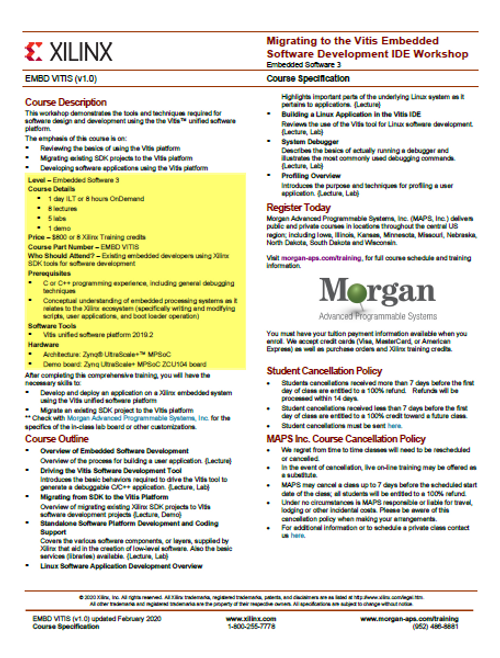This course provides Xilinx MPSoC and ACAP developers powerful tools and techniques to hit the ground running on your Xilinx embedded design project. By including custom real-world labs developed by Morgan Advanced Programmable Systems, Inc., engineering participants in this course will be excited and challenged to learn little known but simple techniques to significantly increase the number of design iterations per day.
These custom labs are based on the real-world situations engineers in industry must deal with, such as revision control, rapid verification (HW and SW), remote development, concurrent development, troubleshooting, and changing requirements.
Additionally, practical real-world tips and techniques are given, so that you will be equipped to quickly find their way through what would otherwise seem like a wild jungle.
This course provides embedded systems developers experience with creating Custom Hardware, baremetal/R5 and embedded Linux/A53 system targeting Xilinx MPSoCs and RFSoC using the PetaLinux tools. The techniques learned here can also be easily applied to lower cost Zynq-7000 embedded designs (both baremetal and Embedded Linux).
The course provides experience with:
- Custom Hardware development
- Creating and packaging IP in Vivado
- Baremetal driver and application development
- Using PetaLinux/Yacto tools to build an embedded Linux OS
- Creating and debugging Linux applications
- Creating and debugging Linux drivers for custom hardware
- Building the environment and booting the system using the Arm® processors available in Xilinx SoCs
- Customizing the root file system
- Configuring the Linux environment and network components
- Trouble shooting hardware and software applications simultaneously using Vivado Logic Analyzer and the Vitis SDK.
The primary focus is on embedded baremetal/R5 and embedded Linux/A53 development in conjunction with the Xilinx tool flow, but the techniques learned in this class can be used for other Xilinx devices with embedded and application processors.
See also
- EMBD-88080: Xilinx Embedded Design for Rapid Development course description
- EMBD-ZUPSA: Zynq UltraScale+ MPSoC for the System Architect course description
- EMBD-ZUPSW: Zynq UltraScale+ MPSoC for the Software Developer course description
- EMBD-ZUPHW: Zynq UltraScale+ MPSoC for the Hardware Designer course description
- Xilinx training schedule and registration







